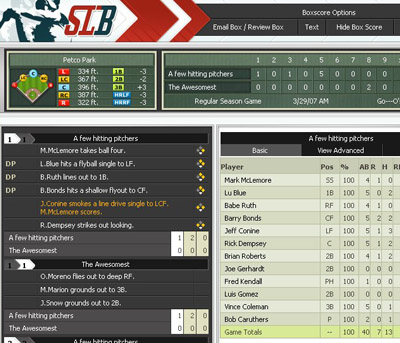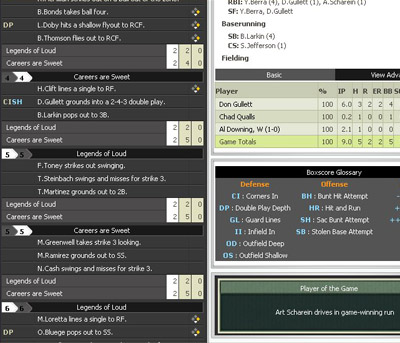SimLeague Baseball Player's Guide
Playing the Games – The Engine and Normalization
The simulation engine that "plays" the games in SLB has greatly improved over the last several years to the point that we feel just about every possible situation from real baseball occurs in SimLeague Baseball and at very similar rates as in real-life.
The boxscore includes a detailed play-by-play that alludes to many of the intricacies of the sim engine. This is also a good place to see how managerial settings are being incorporated. Still, from the boxscore it may not be clear how the engine determines the results of each plate appearance. Here is a quick note on normalization and a brief explanation of the plate appearance decision-tree:
Normalization is a way to account for a player's performance relative to the rest of his league from that season (or entire career) in order to level the playing field for a league that mixes and matches from different eras and styles. Normalization places the batter and pitcher in a neutral era that is about half-way between the two players. Because of this most players will be playing in different eras and parks and facing different opponents than they did in real life. As a result, players should not expect to match their real-life stats exactly. Still, the player's raw numbers account for at least half of the equation, while his numbers compared to his peers account for the rest, so raw numbers are good place to start. Every event in the decision-tree is normalized but hit by pitch.
We have done quite a bit of research to determine the impact of the batter, pitcher, defense and ballpark on each event. Historically, the batter and pitcher do not influence each event equally. To determine the outcome of each ordinary plate appearance, we first look at hit by pitch and walks which are not adjusted by ballpark or defense. Then we adjust a player's normalized batting average based on the ballpark and compare it to the opponent's average (OAV) of the pitcher to determine if the outcome is a hit. If it is a hit, we determine what type. Non-homeruns may be robbed through defense (+ plays). If the play is an out, we determine whether it is a strikeout or in play. Outs in play may become hits (- plays) or errors through defense.
Pitchers also experience in-game fatigue during game simulation. They begin the game at their listed fatigue, but will begin a non-linear decline after reaching their actual average pitches/game.



